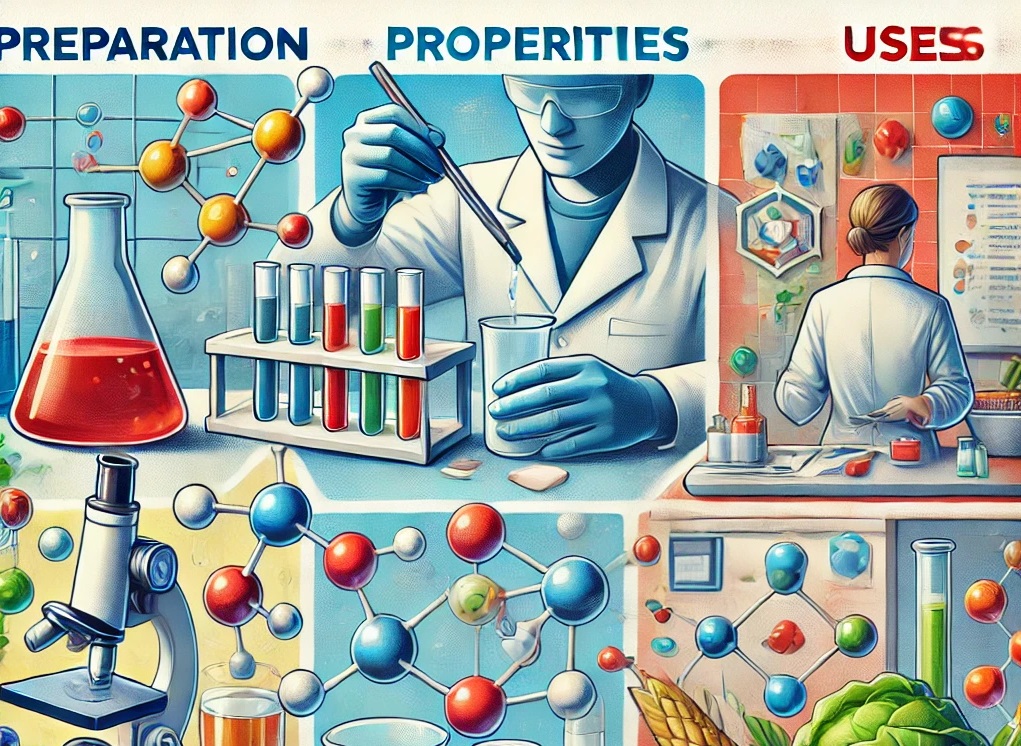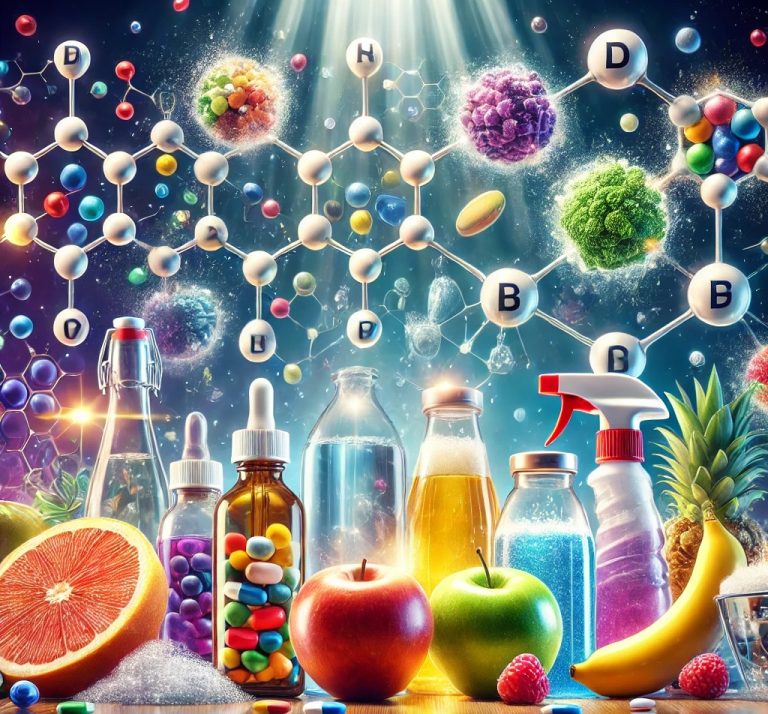Preparation, Properties, and Uses of Polymers
Polymers are large molecules made up of repeating structural units, or monomers, that are chemically bonded together. These macromolecules exhibit unique properties that make them versatile and indispensable in a wide range of industrial and commercial applications. The preparation, properties, and uses of polymers are central to numerous fields, from packaging and textiles to biomedical applications and electronics. Understanding the processes involved in polymer synthesis, the physical and chemical properties of polymers, and their practical uses provides insight into how these materials contribute to modern technology and daily life.

1. Preparation of Polymers
The preparation of polymers involves a process known as polymerization, where small monomer units join to form long chains or networks of polymers. This process can be carried out in several ways, depending on the type of polymer being synthesized and the desired properties. There are two main types of polymerization processes: addition polymerization and condensation polymerization.
1.1 Addition Polymerization (Chain-Growth Polymerization)
Addition polymerization involves the linking of monomers with unsaturated bonds, typically carbon-carbon double bonds, to form a polymer. This type of polymerization is widely used for synthesizing thermoplastics, such as polyethylene (PE), polystyrene (PS), and polypropylene (PP).
Key Stages in Addition Polymerization:
- Initiation: A free radical, cation, or anion is formed to start the polymerization. The initiator reacts with the monomer, opening the double bond and creating an active site for further polymerization.
- Propagation: The active site on the growing polymer chain reacts with another monomer, extending the chain.
- Termination: The polymerization stops when two growing chains combine or the active site is deactivated.
Examples:
- Polyethylene: The most common plastic, used in bags, containers, and bottles.
- Polystyrene: Used in disposable cutlery, packaging materials, and insulation.
- Polypropylene: Used in textiles, automotive parts, and food containers.
1.2 Condensation Polymerization (Step-Growth Polymerization)
Condensation polymerization occurs when monomers with two or more functional groups react to form a polymer while releasing small molecules, such as water, methanol, or hydrogen chloride. This process is commonly used to make thermosetting polymers, like Bakelite and polyester.
Key Stages in Condensation Polymerization:
- Step 1: Two monomers with complementary functional groups react to form a dimer, releasing a small molecule.
- Step 2: The dimer reacts with another monomer, forming longer polymer chains.
Examples:
- Nylon: Used in clothing, ropes, and automotive parts.
- Polyester: Found in clothing fibers (e.g., PET), bottles, and films.
- Polyurethanes: Used in foams, adhesives, and coatings.
1.3 Copolymerization
In addition to homopolymerization (where one type of monomer is used), copolymerization involves the use of two or more different monomers. This can lead to polymers with improved or tailored properties. Random copolymers, block copolymers, and alternating copolymers are some examples, each with distinct structural arrangements and characteristics.
Example:
- Styrene-Butadiene Rubber (SBR): A copolymer of styrene and butadiene, widely used in tire manufacturing for its durability and wear resistance.
2. Properties of Polymers
Polymers exhibit a broad range of physical and chemical properties that depend on their molecular structure, the nature of the monomers, and the type of polymerization. These properties make polymers suitable for diverse applications across various industries.
2.1 Physical Properties
- Molecular Weight: Polymers have a high molecular weight, which directly influences their strength, toughness, and processability. Higher molecular weight polymers tend to have improved mechanical properties but may be more difficult to process.
- Crystallinity: Some polymers are crystalline, meaning their polymer chains are ordered and aligned in a regular pattern. These polymers tend to be stronger and more durable. Examples of crystalline polymers include high-density polyethylene (HDPE) and nylon. On the other hand, amorphous polymers, such as polystyrene and polycarbonate, have random polymer chain arrangements and are more transparent and flexible.
- Density: The density of polymers can vary significantly depending on their structure. Crystalline polymers have a higher density, while amorphous polymers are less dense.
- Solubility: Solubility of polymers in various solvents depends on their chemical structure. Polar polymers (e.g., polyvinyl alcohol) are more soluble in polar solvents like water, while nonpolar polymers (e.g., polyethylene) tend to be insoluble in most solvents.
2.2 Thermal Properties
- Glass Transition Temperature (Tg): This is the temperature at which an amorphous polymer transitions from a rigid, glassy state to a flexible, rubbery state. Polymers with a low Tg, such as polybutadiene, are more flexible, while those with high Tg, like polymethyl methacrylate (PMMA), are more rigid.
- Melting Point (Tm): Crystalline polymers have a well-defined melting point, whereas amorphous polymers soften gradually over a range of temperatures.
- Thermal Stability: The ability of a polymer to resist decomposition at high temperatures. Polymers such as polytetrafluoroethylene (PTFE) and silicone exhibit excellent thermal stability.
2.3 Mechanical Properties
- Tensile Strength: This refers to the maximum stress a polymer can withstand while being stretched. Polymers like nylon and polycarbonate have high tensile strength and are used in structural applications.
- Elasticity: Elastic polymers, such as rubber, can return to their original shape after being stretched. Elastomers like natural rubber and silicone are designed for high elasticity.
- Hardness: The ability of a polymer to resist indentation or scratching. Polyurethane is often used in hard coatings because of its high hardness.
- Impact Resistance: The ability of a polymer to absorb impact without breaking. Polycarbonate and polyvinyl chloride (PVC) are commonly used in applications where impact resistance is essential, such as in eyewear lenses and pipes.
2.4 Chemical Properties
- Chemical Resistance: Some polymers are highly resistant to chemicals, acids, and bases. For example, polypropylene (PP) and PTFE are chemically inert and are used in harsh environments like chemical tanks and piping.
- Biodegradability: Some polymers, such as polylactic acid (PLA) and polyhydroxyalkanoates (PHA), are biodegradable and break down more easily in the environment, making them more sustainable alternatives to conventional plastics.
3. Uses of Polymers
Polymers are used in a vast range of industries due to their versatility, cost-effectiveness, and unique properties. Below are some of the key areas where polymers are extensively used:
3.1 Packaging
The packaging industry is one of the largest consumers of polymers. Polymers like polyethylene (PE), polypropylene (PP), and polyethylene terephthalate (PET) are used in packaging materials due to their strength, flexibility, and ability to be molded into various shapes. Polyethylene is used for plastic bags, wraps, and containers, while PET is commonly used in beverage bottles and food packaging. Polymers help preserve food and beverages by providing barrier protection, preventing contamination and extending shelf life.
3.2 Automotive Industry
Polymers play a vital role in the automotive industry, where they are used in various parts to reduce weight, enhance safety, and improve fuel efficiency. Polyurethane foams are used in seats and insulation, while polypropylene (PP) is employed in bumpers and dashboard components. Polycarbonate is used for windows and headlamp lenses, while nylon and polyester are utilized in engine components, hoses, and belts.
3.3 Medical Applications
Polymers are essential in the medical field due to their biocompatibility, versatility, and ability to be sterilized. Polylactic acid (PLA) and polyglycolic acid (PGA) are used in biodegradable sutures, while silicone is commonly used for implants and prosthetics. Polyurethane is used in medical devices, such as catheters and wound dressings. Polymers also play a role in drug delivery systems, where they are used to control the release of medication over time.
3.4 Textile Industry
In the textile industry, synthetic polymers such as nylon, polyester, and spandex are used to create fabrics that are durable, elastic, and resistant to wrinkles. Polyester is commonly used in clothing, upholstery, and home furnishings, while spandex is used for activewear due to its stretchability. Nylon is used in hosiery, carpets, and industrial fabrics.
3.5 Electronics and Electrical Industry
Polymers are widely used in the electronics and electrical industries due to their insulating properties, flexibility, and durability. Polyvinyl chloride (PVC) and polyethylene are used in the insulation of wires and cables. Polymide and polycarbonate are used for printed circuit boards, electronic housings, and displays. Polymers provide lightweight and cost-effective solutions for electronic components.
10 Questions and Answers related to Polymerization, Properties, and Uses of Polymers:
1. What is polymerization?
Answer: Polymerization is the process by which small molecules called monomers chemically bond to form a large, chain-like structure called a polymer. There are two main types of polymerization: addition polymerization, where monomers add to a growing chain without releasing any by-products, and condensation polymerization, where monomers combine with the elimination of a small molecule, like water.
2. What is the difference between addition and condensation polymerization?
Answer:
- Addition polymerization involves monomers with unsaturated bonds (like double bonds) that link together without releasing any by-products. Example: Polyethylene (PE) is made from ethene (ethene polymerization).
- Condensation polymerization occurs when monomers with two or more reactive groups react, releasing a small molecule (usually water or alcohol) as a by-product. Example: Nylon is produced from diamines and dicarboxylic acids.
3. What are thermoplastics and thermosetting polymers?
Answer:
- Thermoplastics are polymers that soften when heated and can be molded into different shapes. They can be reheated and reshaped multiple times. Examples include polyethylene (PE) and polypropylene (PP).
- Thermosetting polymers undergo a chemical change when heated, forming a rigid structure that cannot be re-melted. Examples include Bakelite and epoxy resins.
4. What are the mechanical properties of polymers?
Answer: The mechanical properties of polymers include:
- Tensile strength: The ability of a polymer to withstand stretching forces.
- Elasticity: The ability of a polymer to return to its original shape after deformation (e.g., rubber).
- Hardness: The ability to resist indentation or scratching (e.g., polycarbonate).
- Impact resistance: The ability to resist breakage when subjected to impact (e.g., polypropylene).
5. What is the significance of cross-linking in polymers?
Answer: Cross-linking involves forming chemical bonds between polymer chains, creating a three-dimensional network. This increases the polymer’s strength, rigidity, and resistance to heat and solvents. Cross-linked polymers are more durable and stable. For example, vulcanized rubber is a cross-linked polymer, which gives it greater elasticity and durability.
6. What are the uses of polyethylene (PE)?
Answer: Polyethylene is one of the most widely used plastics. It is used in a variety of applications, including:
- Packaging: Plastic bags, bottles, and containers.
- Medical: Sterile packaging, surgical gloves, and tubing.
- Textiles: For fibers in ropes and textiles.
- Construction: Pipes and insulation materials.
7. What is the difference between crystalline and amorphous polymers?
Answer:
- Crystalline polymers have ordered molecular structures, leading to high density, strength, and stability. Examples include high-density polyethylene (HDPE) and nylon.
- Amorphous polymers have random molecular arrangements, which results in less rigidity and more transparency. Examples include polystyrene (PS) and polycarbonate (PC).
8. How are polymers used in the medical field?
Answer: Polymers have a broad range of applications in the medical field, including:
- Biodegradable sutures: Made from polymers like polylactic acid (PLA) and polyglycolic acid (PGA).
- Drug delivery systems: Polymers can be used to release drugs in a controlled manner over time.
- Medical devices: Polymers like silicone are used in implants, prosthetics, and catheters due to their biocompatibility.
- Wound dressings: Polyurethane is used in advanced wound care products.
9. What are elastomers and what makes them different from other polymers?
Answer: Elastomers are a type of polymer that can return to their original shape after being stretched or compressed, offering high elasticity. This is different from other polymers, which may remain deformed after strain. Examples include natural rubber, silicone, and polyurethane. Elastomers are used in products like tires, gaskets, and seals.
10. What are the environmental concerns related to synthetic polymers?
Answer: Many synthetic polymers, such as polyethylene (PE) and polystyrene (PS), are not biodegradable and can persist in the environment for hundreds of years, contributing to plastic pollution. These materials accumulate in landfills, oceans, and natural habitats. Efforts are underway to develop biodegradable alternatives, like polylactic acid (PLA), and to improve recycling processes to manage polymer waste more effectively.






